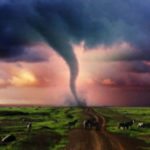 Technology
Technology  Technology
Technology  Humans
Humans 10 Everyday Human Behaviors That Are Actually Survival Instincts
 Animals
Animals 10 Animals That Humiliated and Harmed Historical Leaders
 History
History 10 Most Influential Protests in Modern History
 Creepy
Creepy 10 More Representations of Death from Myth, Legend, and Folktale
 Technology
Technology 10 Scientific Breakthroughs of 2025 That’ll Change Everything
 Our World
Our World 10 Ways Icelandic Culture Makes Other Countries Look Boring
 Misconceptions
Misconceptions 10 Common Misconceptions About the Victorian Era
 Mysteries
Mysteries 10 Strange Unexplained Mysteries of 2025
 Miscellaneous
Miscellaneous 10 of History’s Most Bell-Ringing Finishing Moves
 Technology
Technology Top 10 Everyday Tech Buzzwords That Hide a Darker Past
 Humans
Humans 10 Everyday Human Behaviors That Are Actually Survival Instincts
 Animals
Animals 10 Animals That Humiliated and Harmed Historical Leaders
Who's Behind Listverse?

Jamie Frater
Head Editor
Jamie founded Listverse due to an insatiable desire to share fascinating, obscure, and bizarre facts. He has been a guest speaker on numerous national radio and television stations and is a five time published author.
More About Us History
History 10 Most Influential Protests in Modern History
 Creepy
Creepy 10 More Representations of Death from Myth, Legend, and Folktale
 Technology
Technology 10 Scientific Breakthroughs of 2025 That’ll Change Everything
 Our World
Our World 10 Ways Icelandic Culture Makes Other Countries Look Boring
 Misconceptions
Misconceptions 10 Common Misconceptions About the Victorian Era
 Mysteries
Mysteries 10 Strange Unexplained Mysteries of 2025
 Miscellaneous
Miscellaneous 10 of History’s Most Bell-Ringing Finishing Moves
10 Amazing Natural Events Occurring Right Now
The natural world changes around us, and we’re all just here for the ride. Except now we can influence (many) natural goings-on, at least a little bit. Here’s an automotive analogy: humans aren’t driving the car yet, but at least we’re in the backseat yelling and flicking the driver’s ear.
The following stories highlight the remarkable ways the natural world is changing, with varying levels of hope for human rebuttals.
Related: 10 Ways the World Would Radically Change if Antarctica Melted
10 Oceanic “Fire-Ice” Is Starting to Bubble
The oceans hide all sorts of weirdness, including ice that you can light on fire. This “fire-ice” is made of a “naturally occurring frozen form of methane and water,” and large portions of it reside beneath the oceans surrounding continents.
This marine methane hydrate can melt and release its potent greenhouse gas into the seas and potentially the atmosphere. And it’s potentially a whole lot because recent research suggests that this marine methane hydrate encompasses more carbon than all the Earth’s oil and gas.
The release of methane from beneath the ocean floor has occurred throughout natural history and is linked to our planet’s most intense climate change events. As the current climate continues to deteriorate, global warming will threaten to melt more of this relatively shallow hydrate around the continents.[1]
9 Death Valley Has a Lake
It’s an understatement to say that Death Valley is hot and arid. At more than 280 feet (85 meters) below sea level, Death Valley’s Badwater basin is the lowest place in North America. It’s also the hottest and the driest, completing a terrible thermal trifecta.
Tens of thousands of years ago, it was Lake Manly. Now it’s a salt flat. Or it was because California’s heavy rains have turned it into a temporary lake about 12 inches ((30 cm) deep and 6 miles (9.7 kilometers) in length at its longest. The flooding of the bone-dry Death Valley’s basin occurred a few times in the past decades.
This lake is actually a refilling of a slightly larger (7-mile long, 2-foot deep or 11.2-meter deep, 0.6-meter deep) ephemeral lake that filled due to Hurricane Hilary’s rainfall in August 2023. Unfortunately, the more recent storms this year, caused by atmospheric rivers, put 37 million people at risk of flooding.[2]
8 Bee Populations Aren’t Doing That Great (but Also Not That Terrible)
Bees are at risk, and it’s easy to see why that’s a big deal: These fuzzy little anthophiles pollinate “more than 100 of the crops we eat, including nuts, vegetables, berries, citrus and melons.” Now, those are some tasty crops!
Yet all sorts of factors are killing bees, including pesticide use, climate change, parasitic mites, and even a dearth of nutrition. That’s bad for bees, as always. But, maybe surprisingly, PBS reports that commercial beekeepers have kept the overall bee colony populations stable. How? They “split and restock their hives, finding or buying new queens, or even starter packs for colonies.”
The situation isn’t improving, but it’s also not getting worse, at least in some scenarios. So bees are not (at this moment) facing an “apocalypse.” That’s a positive, considering the overwhelming percentage of our favorite goodies that depend on bees. However, the work necessary to keep it that way stresses both bees and beekeepers. [3]
7 An Explosive Hurricane Season Will Accost Us
As the world gets warmer, consequences will increasingly abound. Some are abounding now, as apparent from heat-induced dangers like droughts and waves of lethally high temperatures around the world.
On top of that, it appears we’ll be in for an “explosive hurricane season.” Oceanic metrics show us why: As of February this year (2024), the “average global sea surface temperature was the highest ever recorded, at 69.9 degrees” Fahrenheit (21.02 degrees Celsius. The thermal rise is not globally consistent, as temperatures rise faster in some places, including the Arctic.
Alarmingly, it’s forecasted that by the 2030s, only a quarter of today’s Arctic ice coverage could remain. Combined with the effects of La Niña (winds blowing away from the Americas, bringing cold water to the surface), this warming will smack us with horrid hurricane seasons.[4]
6 Termites Are Set to Grow Hungrier
Termites get a bad rap as dwelling-destroyers, but only about 4% of them are of the house-eating variety.
However, rising temperatures may put these bugs into overdrive. For example, when it’s 86 degrees Fahrenheit (30 degrees Celsius), the termites will gobble up woody material seven times faster than they would at a much cooler 68 degrees Fahrenheit (20 degrees Celsius). Plus, as the planet warms, termites will increase their domain across our planet, eating more and more wood.
This is not good because wood does a really sweet job of trapping carbon. The longer that carbon can remain trapped in plant life, the better it is for controlling Earth-toasting emissions. Yet when deadwood is rapidly eaten or broken down, that carbon rejoins the wrong side of the balance.
When scientists did different tests to identify the rate of deadwood consumption, they found something not so great. For every 10-degree Celsius increase, termites increased their wood-eating capacity by a factor of seven. Climate change, it appears, isn’t bad for every creature—at least the termites will prosper.[5]
5 Parts of the Atlantic Turn to Brown Goo Every Summer
The tropical Atlantic turns into gross, brown goo every spring and summer. The region is accosted by a blooming of big, brown, free-floating algae. The algae are called Sargassum, as per the area, and the bloom has been a yearly event for over a decade.
The clumps and aggregations are such a nuisance and so large that they’re being tracked by satellite. There’s also “the Great Atlantic Sargassum Belt,” growing near the equator where the north and south winds meet.
Sometimes, gigantic mats escape their currents and wash ashore in tropical locales like the Caribbean and Florida. They muck up the beaches, blocking access and creating huge, stinking, decomposing messes. Oh, and they can also be toxic, with high concentrations of heavy metals like arsenic. Why not![6]
4 Microbes Are Becoming Hardier
Antimicrobial resistance (AMR) is becoming a problem for many. The World Health Organization (WHO) says that AMR is responsible for nearly five million global deaths per year. It’s one of the biggest emerging threats to human health worldwide, especially affecting lower-income countries. AMR happens as “bacteria, viruses, fungi, and parasites change over time and no longer respond to existing treatments,” so it’s unavoidable to some extent.
However, recent research says that the strategic use of existing and developing vaccines in broad populations could save many lives. In total, around 1.7 million per year (half a million in “key populations” and an additional 1.2 million in “broader populations”), as well as 37 million disability-adjusted life-years (DALYs), a measure of years lost to disability and, well, death [7]
3 Modern Sandstorms Are More Dune-Like
Many have only experienced dust storms while watching Dune or Sahara Desert documentaries. But for millions living in desert communities, dust storms are a terrifying, potentially lethal problem.
Worse yet, the incidence of dust storms is steadily increasing as the climate continues to change for the worse. According to the UN Environment Programme, 330 million people are affected globally, and that figure is rising. As the world warms and semi-arid areas lose vegetation and become full-on arid, deserts proliferate, and the storms increase in their hot, dusty brutality.
The overall figures are staggering: dust storms cause billions in damages and untold health costs, including an estimated 400,000 premature deaths caused by dust particle exposure.[8]
2 Winds Are Scattering Microplastics from Fertilizers
Treated sewage sludge makes natural fertilizers that enrich fields and crops. Sounds good: less poo and more food! But research has discovered a downside, as is often the case with things that sound really useful. A study from the Environmental Science & Technology Letters of the ACS (American Chemical Society) found that these fertilizers come with an even nastier ingredient: microplastics.
These microplastics are so tiny that they’re easily lifted by a light breeze, even when a similarly sized dust grain would not become airborne. Since these tiny plastics aren’t “sticky,” they are not trapped by soil and can be scattered by the lightest zephyr.
Worse yet, some of these microplastics may carry contaminants from wastewater, making them potentially more harmful than regular microplastics, which are increasingly being found in the human body and just about everywhere else, including in clouds. Overall, microplastics could be released from “barren agricultural fields from nearly two and a half times more wind events than previously estimated.”[9]
1 A “New Star” Is Set to Brighten Our Skies
In addition to the seas, air, and land, a fantastic phenomenon will brighten our skies sometime this year: a “new star.” That’s right, toward the last few months of the year, we’ll most likely be privy to a dazzling space show that hasn’t occurred in 80 years. T Coronae Borealis, or T CrB, will burst to life. Or, technically, burst to partial death.
T CrB is a double-star system located 3,000 light years away. One of the stars is a white dwarf, like the future corpse of our own Sun. This white dwarf’s intense gravity is sucking up matter from its stellar companion, a giant, dying red star.
When the white dwarf gobbles up enough matter and hits a specific threshold, its outer layers will explode in a nova (partial supernova). Then, the process resets, building toward another nova eight decades from now. If you enjoyed the eclipse earlier in the year, this exploding cosmic zombie should be an awe-inspiring sight.[10]








